Gran Hotel Miramar, Málaga
last update: 31 December 2020
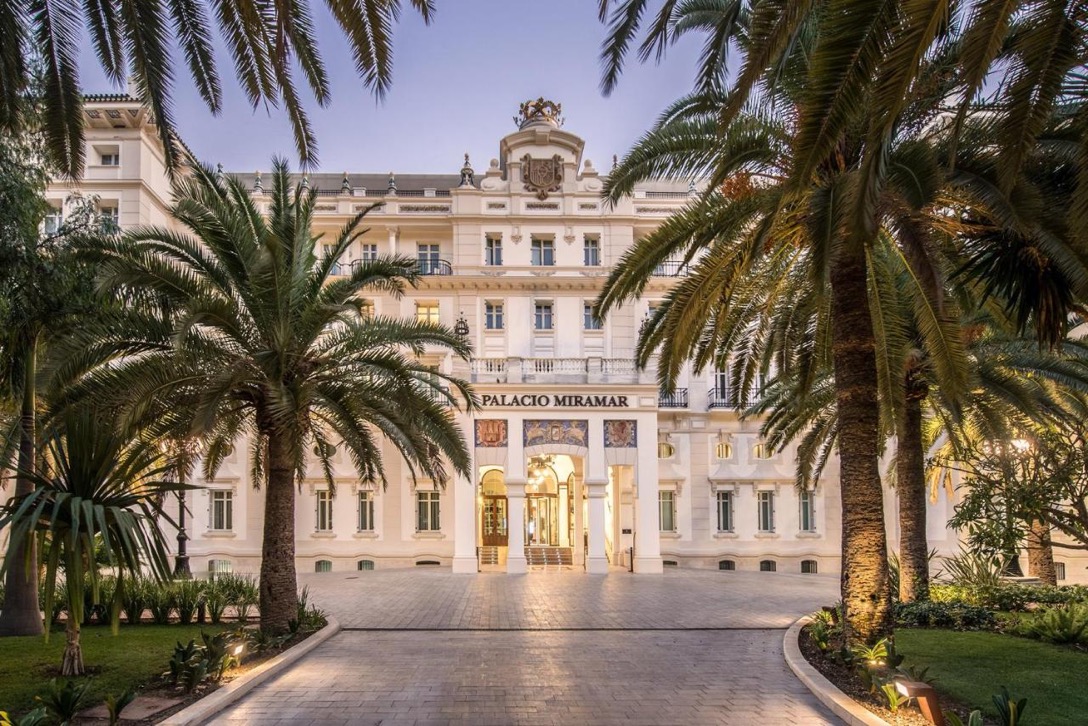
We celebrated the end of 2020 and the New Year 2021 in the Gran Hotel Miramar in Málaga. This is a 5-star Grand Luxe (GL) beachfront hotel sitting on the La Malagueta Beach. It belongs to Hoteles Santos, a Spanish company with a collection of 4- and 5-star hotels. The Gran Hotel Miramar is a member of The Leading Hotels of the World. In preparing this hotel review, we also noticed that we had spend the 2018-2019 Christmas-New Year at another of the Santos hotels, the Hotel Balneario Las Arenas in Valencia.
The Grand Luxe (Gran Lujo) classification in Spain is used to indicate a hotel that is located in a building of historical or cultural significance. In addition the service is expected to be better than from a 'normal' 5-star hotel, e.g. providing extraordinary levels of luxury and exclusivity. The 'Gran Lujo' classification is attributed by the Andalucia Tourist Board, but there is an on-going discussion concerning the exact criteria of selection, and why certain hotels are included or excluded.
We booked directly with the hotel, but Booking gave it a 9.3 (superb), calling it 'quite spectacular' and the best hotel in Málaga. They recommended, budget permitting, a room with a sea view. Booking stressed the "private bathroom equipped with a bath, mirror with temperature and clock and Bulgari toiletries", even if a "private bathroom" might well be expected of a 5-star GL hotel. Frankly, I'm not sure a mirror with a clock is going to convince the discerning traveller, but the fact that this hotel is the only 5-star GL resort hotel in Málaga might just do it.
Many reviews highlighted the hotel for its spectacular architecture and modern facilities, although some people felt the decoration to be a bit kitsch.
COVID-19 oblige
Before we review our stay in this 'palace', let's look at how it dealt with COVID-19. Arriving at the main entrance we were met …. by no one. There was a disinfectant-gel dispenser (naturally, a very expensive looking chrome dispenser) at the entrance, and near all the lifts, etc. The only noticeable new feature at the reception was a velvet-rope barrier to stop clients leaning on the reception surfaces and getting too near to hotel staff. However, check-in still involved handing over passports and a credit card, physically signing in (separately for myself and my wife), and receiving a paper hand-folded with two electronic keys. The receptionist brought our luggage to our room. We parked our car ourselves. Check-out was also not contactless.
How did this compare with our previous hotel? Over Christmas 2020 we stayed in a 4-star hotel in Ronda. Also upon our arrival, no one welcomed us. The reception area was marked out and there were gel dispensers in several places, e.g. in the reception area, next to lifts, etc. Passports and our credit card were scanned without staff touching them, using a small scanner on the reception desk. My wife did not need to sign in, and we received a small pre-prepared envelop with the electronic keys, etc. We took our own luggage to the room, and parked our car ourselves.
The hotel room had a label on the door telling us that it was a "sanitised room". In the room there was no paper information, menus, etc. (information was available on the TV). The bins in the bedroom and bathroom had plastic bag liners. There were no glasses in the room, only four small paper coffee cups (the mini-bar was still full of drinks). The floor and furniture surfaces looked easy to clean, and the seating was a kind of textured plastic that could be easily cleaned. However, on the bed there was a throw and two sets of decorative cushions.
Comparing this room with our previous hotel, the room had also been "sanitised". In the previous hotel the furniture was textile based, and probably difficult to sanitise, and there was a full set of glasses, etc. However the bins had plastic bag liners, there were no throws or extra cushions on the bed, and menus, etc. were available with a QR code.
In both hotels, room service was delivered to the door, and staff did not enter the room. Everyone wore masks.
My wife and I were impressed that in both Ronda and Málaga everyone wore masks everywhere, indoors and outside in the street.
Arriving at the hotel
Firstly the façade that is often presented on the different websites does not face the sea, it faces on to the Paseo Reding, and is part of a one-way circuit which runs back along the beach side on Paseo Maritimo Pablo Ruiz Picasso, .
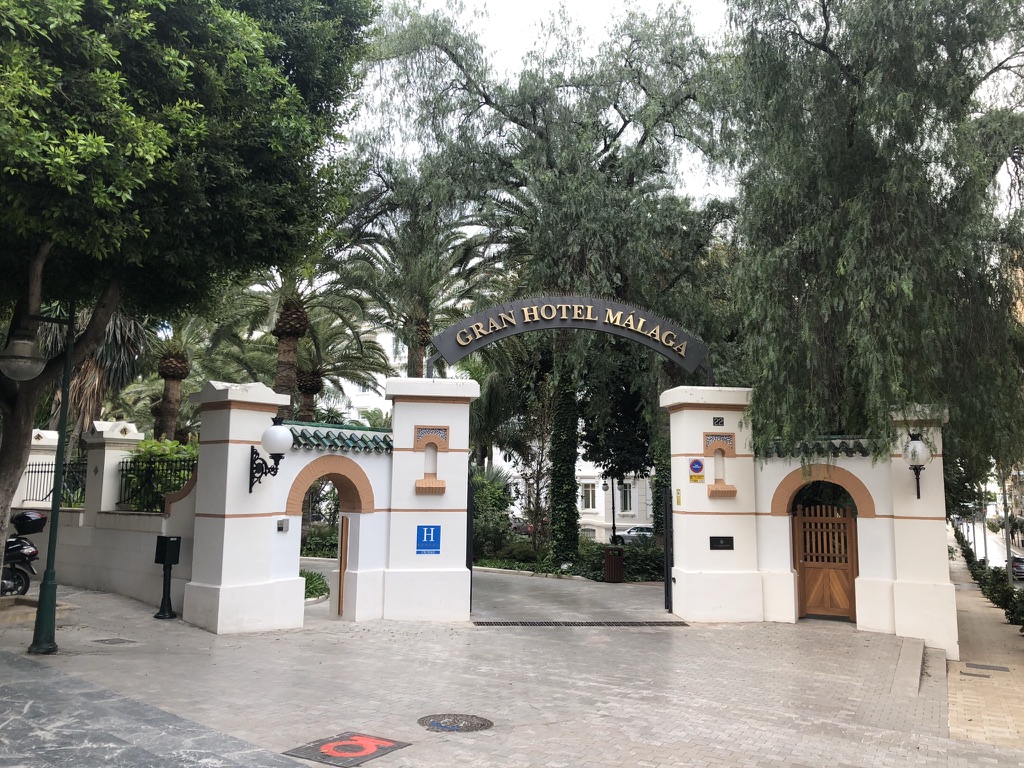
Our cars navigation system faithfully delivered us to the entrance, only for me to decide that we were looking for the Gran Hotel Miramar, and not the Gran Hotel Málaga. Second time round we did not make the same mistake.
Frankly this is one of the few hotels I have seen which, when arriving, looked just like the photographs on the web. Summarising in one word - Impressive!
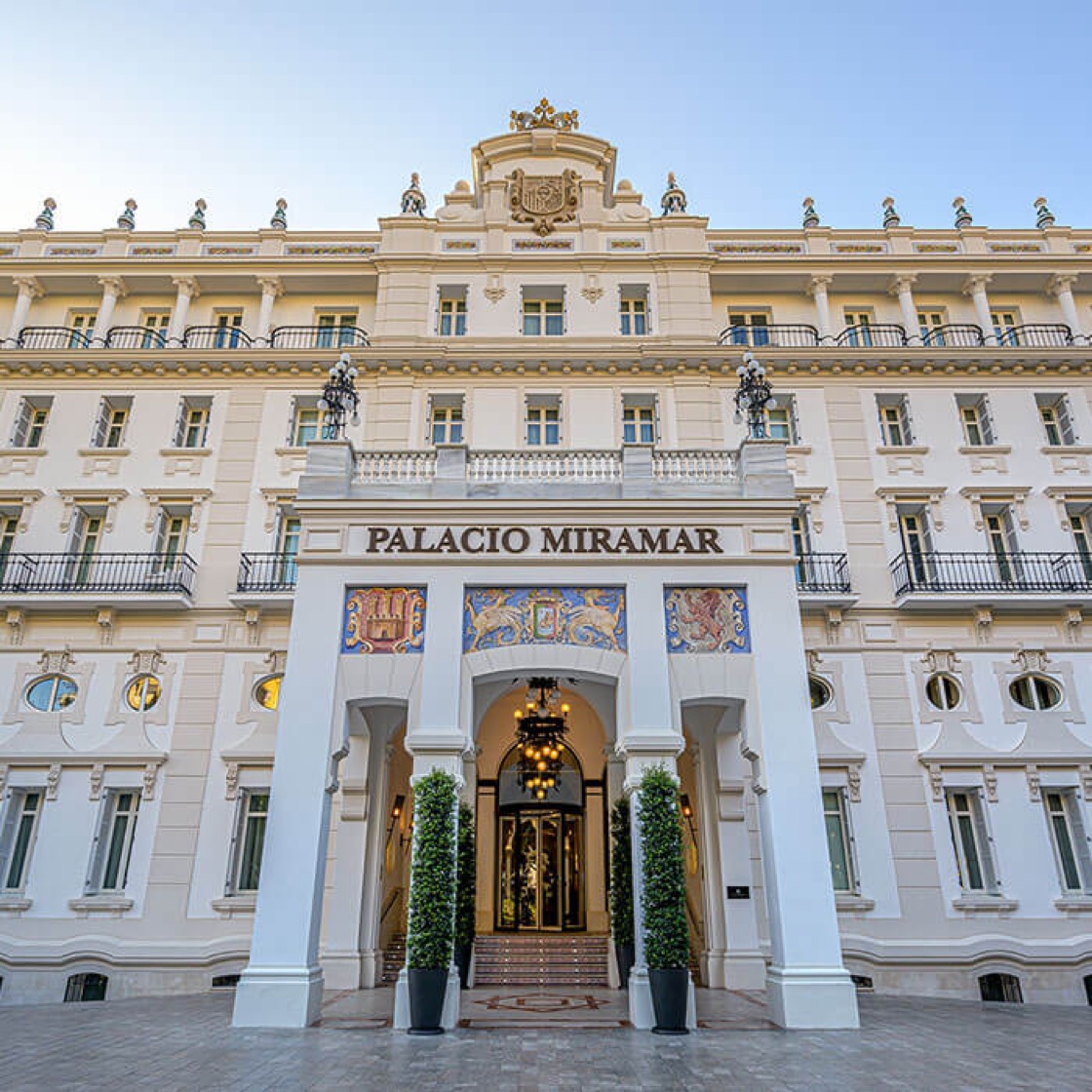
A little bit of history
The original hotel was finished in 1926, and was the work of the architect Fernando Guerrero Strachan (Spanish, 1879-1930). It was located on a complete block consisting of a trapezoidal plot of more than 13,000 square metres (see the below plan).
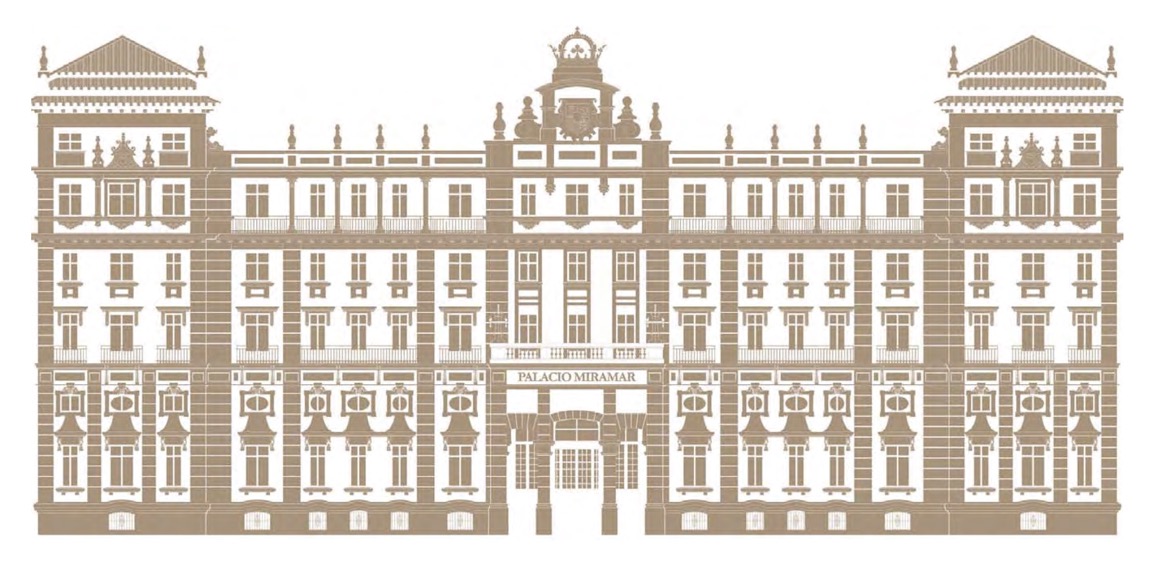
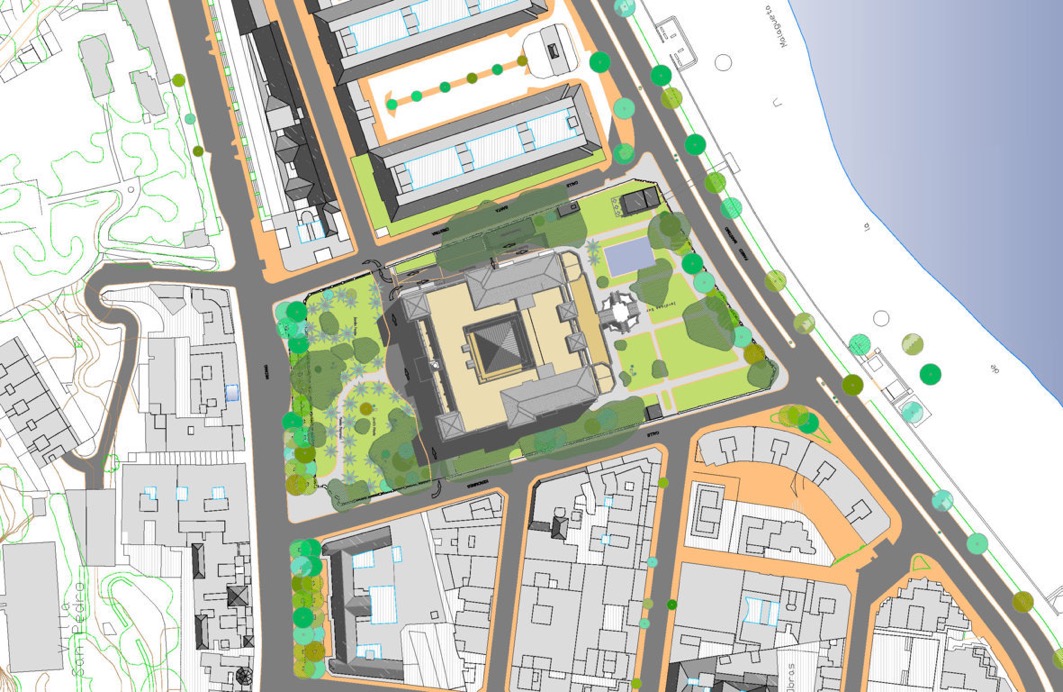
The building itself had a total constructed area of more than 19,000 square metres over six floors. The decorative elements of the original hotel were proposed by a local painter Enrique Jaraba y Jiménez.
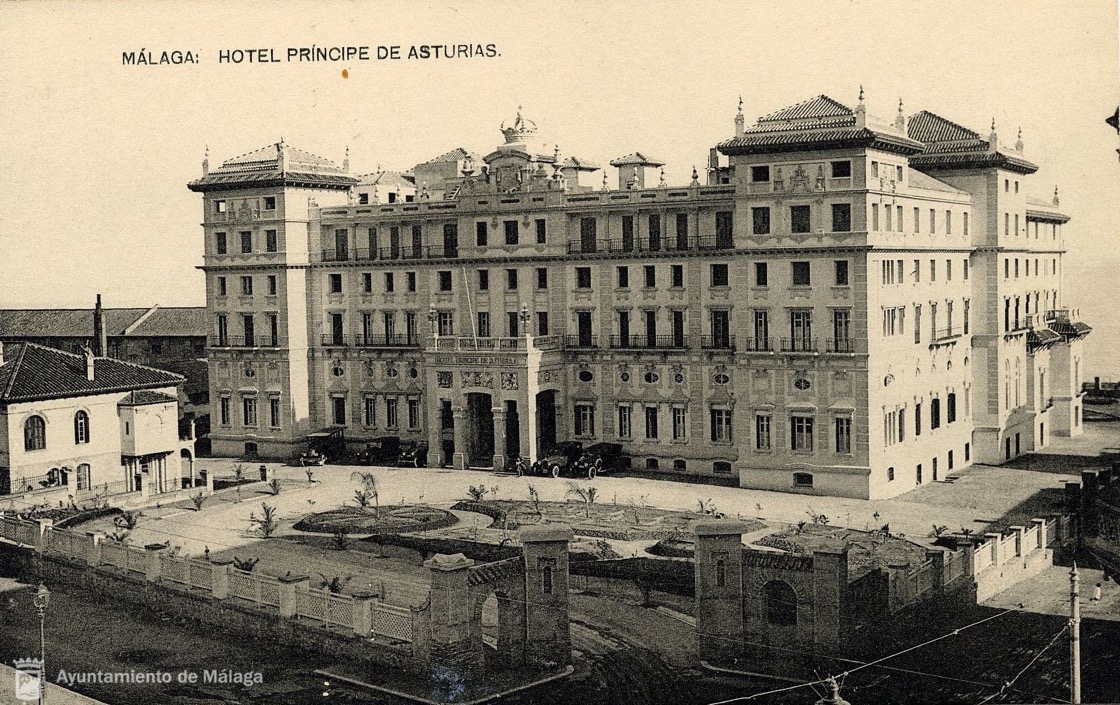
It was inaugurated by King Alfonso XIII and give the name "Hotel Principe de Asturias" (a title associated with the Spanish heir to the throne). With the proclamation of the Second Republic (1931-39) it was re-named "Hotel Miramar" (could be defined as sea-view). During the Spanish Civil War (1936-1939), the hotel was a hospital from the summer 1936 until the taking of the city by Franco's troops in February 1937 (it was called the "Hospital Military de Miramar"). In 1939 it again became a hotel and was operated as such until it closed in 1968.
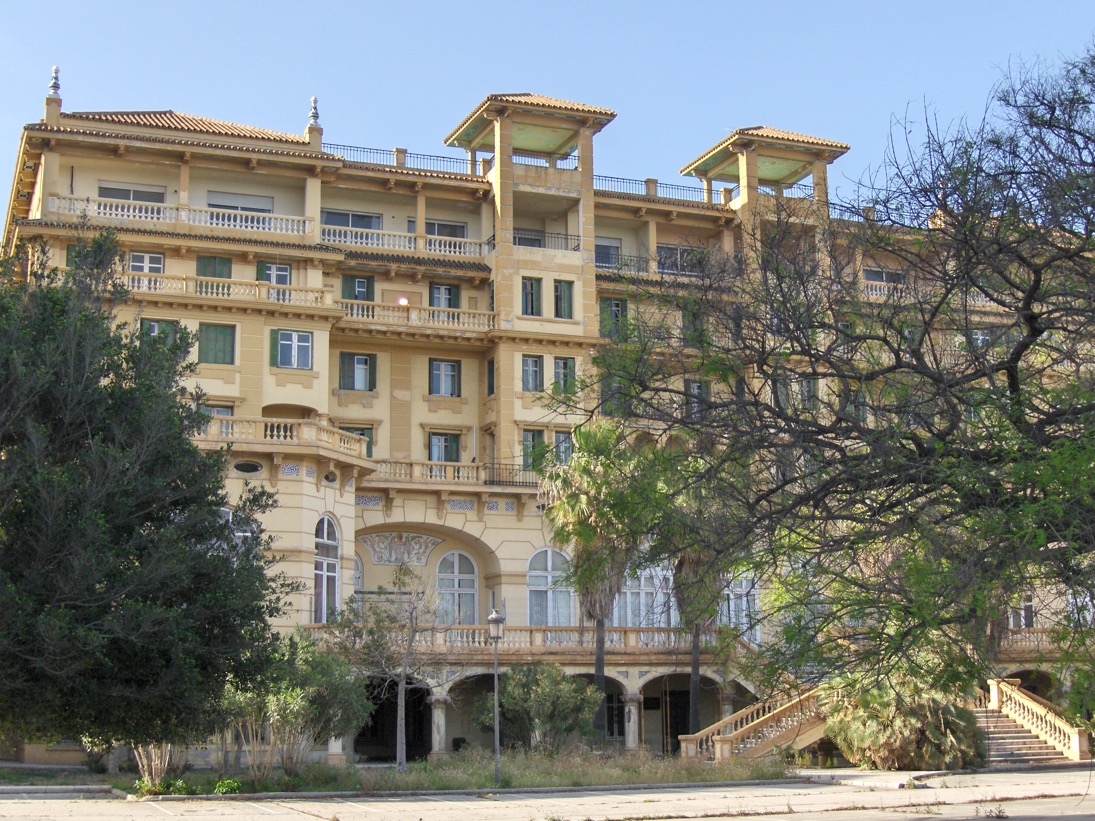
In 1987 the palace (hotel) was acquired by the Ministry of Justice to accommodated the Provisional Court of Málaga, and was only vacated in 2007. The intention was that it would again become a hotel, but the work only started in 2014. The renovated hotel was reopened in December 2016. The architect José Seguí aimed to re-create a luxury hotel by recovering the elements, structure and splendid decoration of the original hotel. There were some problems concerning the iconic stairs (in ruins) and the protection of the trees in the gardens.
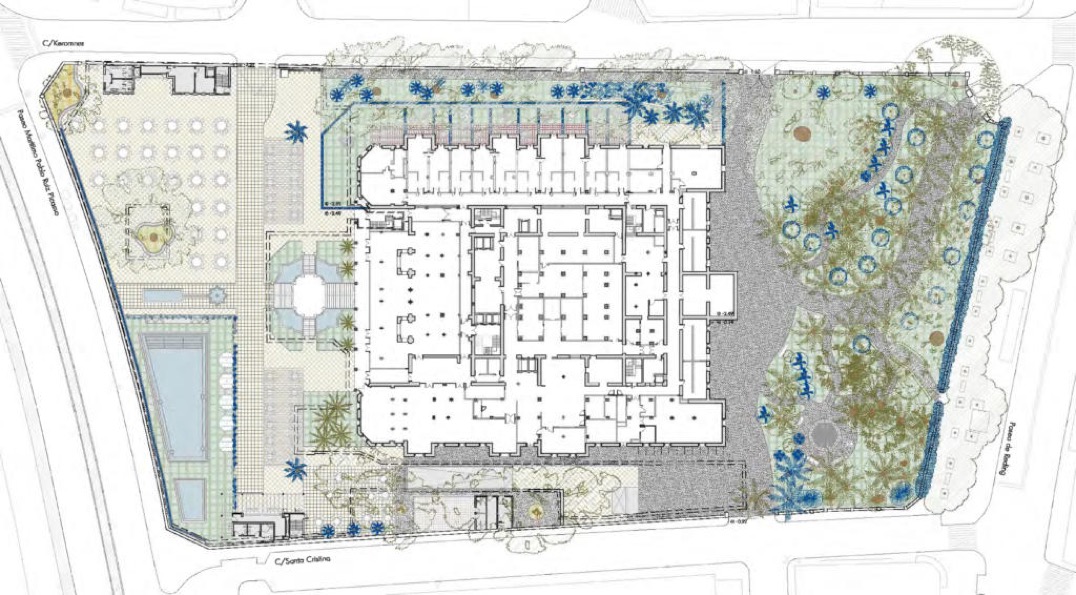
The original hotel had been modelled on the Ritz Hotel in Madrid and the Hotel Rivera Palace (Beau Soleil) in Monte Carlo. So the initial intention was to place this hotel as a reference establishment, at the level of the great European hotels. At the time this meant having a telephone, piped music, and heating in all the rooms, plus an outdoor pool and tennis courts. The original site had been a sugar factory, and it is said that the hotel had kept the factory jetty. It would appear that the hotel was connected to the train network, and it had its own ticket office and luggage check-in facilities. The basic structure had colourful polychrome ceramics, wrought iron, and a mix of Arabic motifs, Salamanca Plateresque (a bit flamboyant) and what was known at the time as French Elizabethan (a kind of late French Renaissance decoration). The original colour was an ochre, but today its a bright white marble colour. The architect has integrated the polychrome ceramics and wrought iron, has kept the covered central atrium, and has protected the extensive Mediterranean gardens. There are a number of rooms that are defined as 'old', which I presume means the decoration is based upon historic archive material.
One very symbolic feature of the restoration was the replacement of the crown. In truth it would appear that it was destroyed during the Spanish Civil War, so no one could remember having seen it in place. However, the crown was part of the original design, and so it was added again to the restored façade. As we can see below, the 3 m high crown is now back in its rightful place.
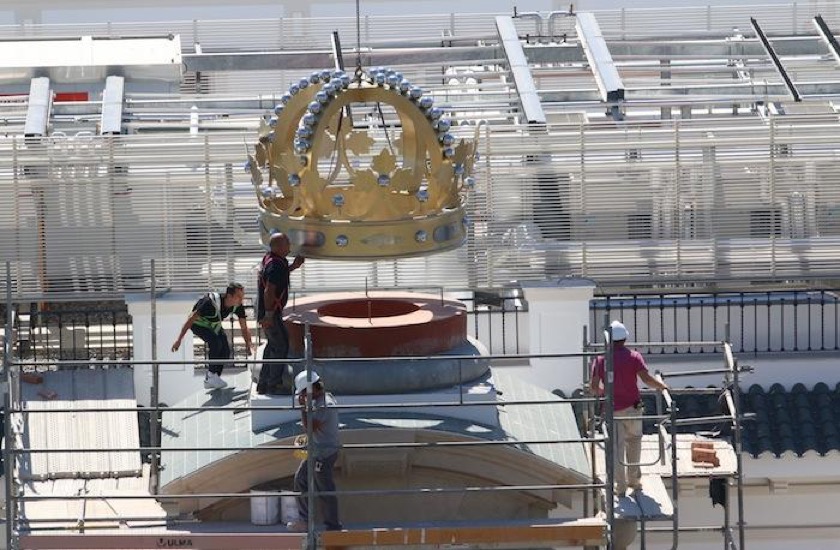
In many respects the restoration project was more than just the creation of a new hotel, it was also to recover a piece of the city's history.
As an interesting aside, hostels were almost certainly a Roman invention, however the 'alhóndiga' (from the Arabic 'al-fondaq') were buildings for the storage and sale of food products, while offering accommodation for those who came to the town to sell them. It was the Christians that gave the 'alhóndigas' an exclusive commercial use as inns to house men and beasts at the entrances to towns. The inns followed the same structure as the Muslim 'al-fundaq', a central patio with galleries opening on to rooms. The ground floor was for living, storage and stables, and the upper floor(s) for accommodation. The inns provided a bed, fodder for the beasts, and a place to cook, but not food. Later the authorities insisted that food also be offered. Everyone slept in these places, so eventually the rich had individual rooms and everyone else slept in communal rooms. The central courtyard became the kitchen and dining room, and the stables were then located at the back.
In Málaga the first inns appeared in the 15th century, and by the mid-18th century there were eleven inns in the city. By this time the inns were owned by aristocrats and ecclesiastical institutions, and some were considered important domestic constructions in the city (I think that word 'parador' comes from these upmarket inns).
In the 18th century new roads were built for stagecoaches, and with regular shipping routes, wealthy people started to travel to see the world. They demanded a different type of accommodation, not just inns or boarding houses. These new types of hotels were often linked to companies dedicated to transporting wealthy travellers looking for adventure and exotic customs (e.g. in Spain). Málaga soon became known to people with lung complaints, and a new generation of more modest establishments appeared. Around 1830 Málaga offered both good quality hotels and guest houses. The guest houses were for travellers who did not want to deal with 'los campersinos' in the posadas but could not afford the hotel.
People disembarking at the port would first see the rich houses along the Alameda (the promenade along the port), and several hotels were already established in these houses. A local guide from 1838 mentioned that Málaga had four better quality establishments and 39 inns. Most descriptions of the time were for inns with a common table for food, and some sparsely furnished, but perfectly clean, private rooms. Reports were that the food was much like English homemade dishes, English cheese and salted butter, excellent desserts, and followed by cigars. However, it was said that the local table wine (dry Málaga) was "totally undrinkable". Oddly, travellers often preferred the local guesthouses, to better immerse themselves in the local culture. In 1845 there were at least three authentic hotels providing quality service and good food, all run by foreigners and having specialist staff. In 1861 a guide wrote of first-rate establishments for those spending the winter "entirely in the English manner". Not everyone was happy, and in 1882 an Englishwoman wrote that her hotel was "bad, expensive and dirty".
It was about this time that people began to consider tourism as a source of wealth, and people began to suggest that Málaga's climate was an economic resource. So it was not just a question of attracting sick people with lung problems, but now the challenge was to seduce rich tourists. However through to the 20th century, the offer was always associated with the city and not with the adjacent coast. New hotels had emerged in the city, almost all around the newly built Calle Larios (1891). These establishments offered a telephone, electricity, bathrooms, 'reading cabinets' and direct communication with the railroad with a permanent horse carriage service. Oddly, the Gran Hotel de España, inaugurated in 1890, was the first building expressly designed as a hotel. Until then all hotels were in converted houses. This new hotel offered "rooms with electric bells, Spanish and foreign newspapers, bathroom and shower rooms, and an excellent kitchen". Others followed, offering elevators, central heating, toilets with hot and cold water in all rooms, and bathrooms in the apartments. The grandest was the Gran Hotel de Roma, who offered in addition, interpreters and luxury cars.
In the 1920's the big hotels started to arrive in Málaga, including the 250-bedroom "Príncipe de Asturias". However, still in 1929, Málaga offered 800 rooms, most in smaller establishments. It was in this period that the beach was discovered, a prelude to mass tourism. Initially sea bathing was therapeutic, but the real revolution was when the sea acquired a playful and sporting character. Floating baths were replaced by cabins, showers, and bar-restaurants. Unban centrality was exchanged for the environmental quality of the coast and beaches, populated by small hotels and recreational chalets, all set in large gardens. New builds included traditional architectural features, such as mullioned windows, gazebos, ironwork arches, polychrome roofs and eaves. These new beach hotels offered a telephone, sea views, hot and cold water, bathrooms with W.C., beaches with bathtubs, elevators, and gardens and dining rooms with terraces and sea views.
The "Príncipe de Asturias" was the most expensive, with rooms costing between 20 and 60 pesetas, the cheapest was the Hotel Inglaterra at 6-7 pesetas per room. To build the "Príncipe de Asturias" a limited company was set up in Madrid in 1920, with an initial capital of 3 million pesetas. It is said that the real promoter was king Alfonso XIII (he laid the first stone in 1921 and inaugurated the hotel in 1926). The site was the old Heredia family sugar factory, and the architect was Fernando Guerrero Strachan. In order to favour the hotel the king sent his mother-in-law for each winter season. She would attract visits from her daughter, and grandchildren, etc. The future George VI of England, and Madame Curie were known to stayed in the hotel. After the Spanish Civil War the hotel, renamed the Miramar, never fully recovered, and closed in 1968.
For a more complete analysis, check out on the web "La Arquitectura del Turismo - Los Orígenes de la Oferta Hotelera en Málaga (silos XIX-XX)", by Víctor Manuel Heredia Flores.
The reception and welcome
The reception area was now equipped with an additional barrier in front of the main desk, plus the usual hand gel, distance marking, etc.

As mentioned above, they touched our passports, credit card, and had us both sign forms, before receiving the electronic keys. The receptionist became a porter and helped us with our luggage. I parked our car myself in the underground parking. Reception areas are often quite dull and lacking a welcoming feeling, and the staff often do little to convince the guest that they are special. And this reception was 'par for the course'.
The central atrium

If the reception was 'neutral', the central atrium is certainly out to impress (in some texts its called the "Royal Lobby"). In addition we had the extra pleasure of the Christmas decorations (more precisely a tree and some fairy lights). Modern day decoration can't really compete with Nasrid decoration.


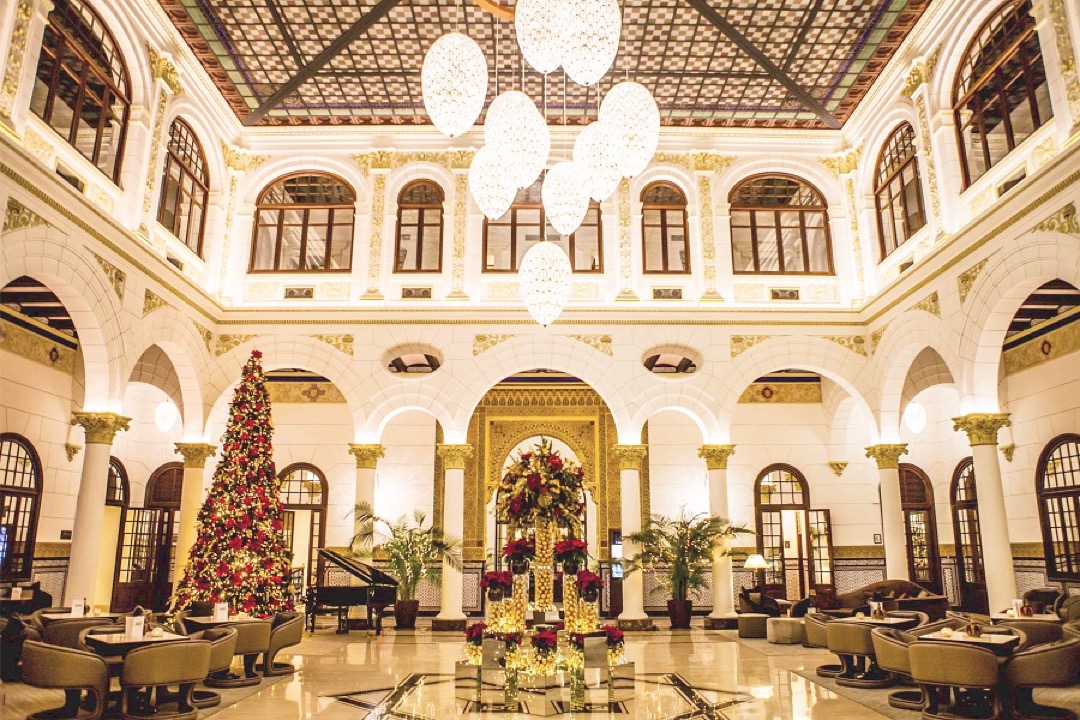
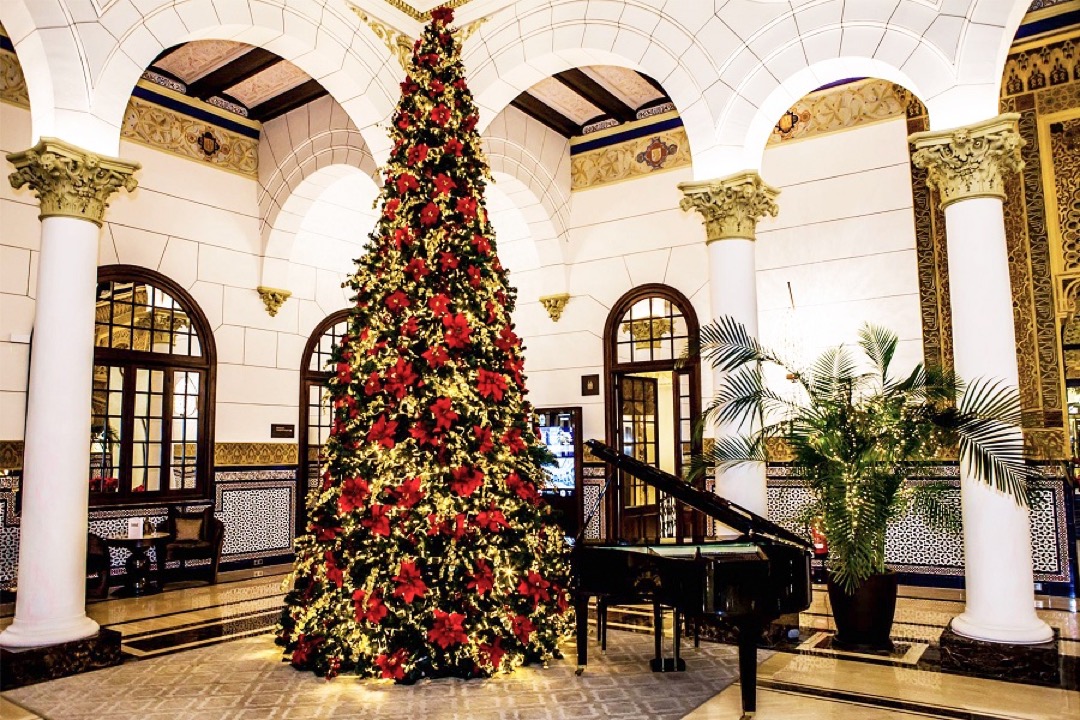
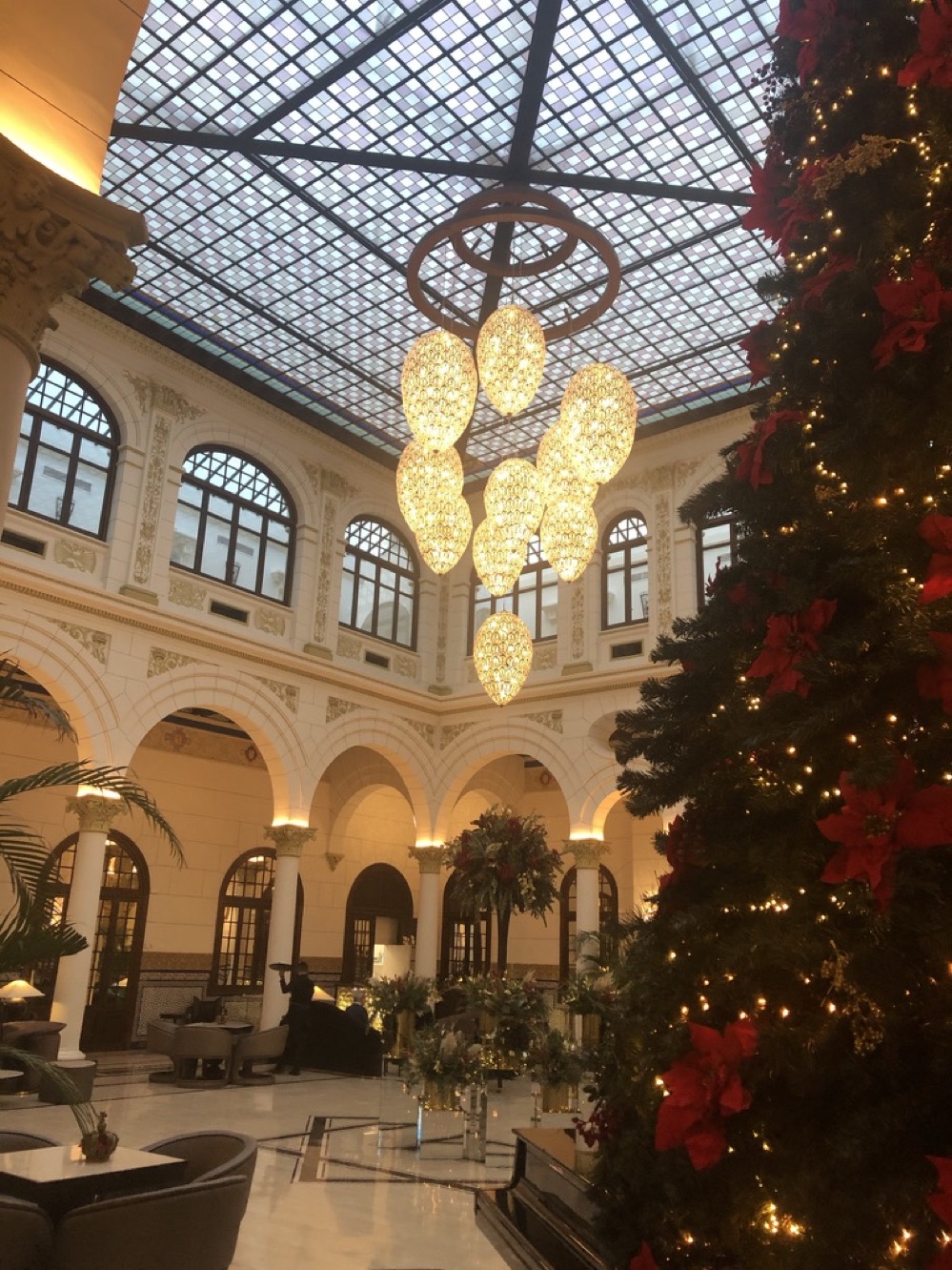
The outside space
No matter how you look at it, the hotel has an impressive outside space. Firstly there is the luscious, almost tropical front gardens.

And there are really two ways to look at the hotel's 'back garden', firstly from our hotel room, and secondly looking back at the hotel from the beach.
Below we have a panoramic view taken from our room terrace, and a close-up of the very attractive outdoor pool on the left. We can see the famous stairs leading down from the restaurant terrace to the ground level, and on the right a variety of reception areas (the area hosted a wedding celebrated on the Saturday).
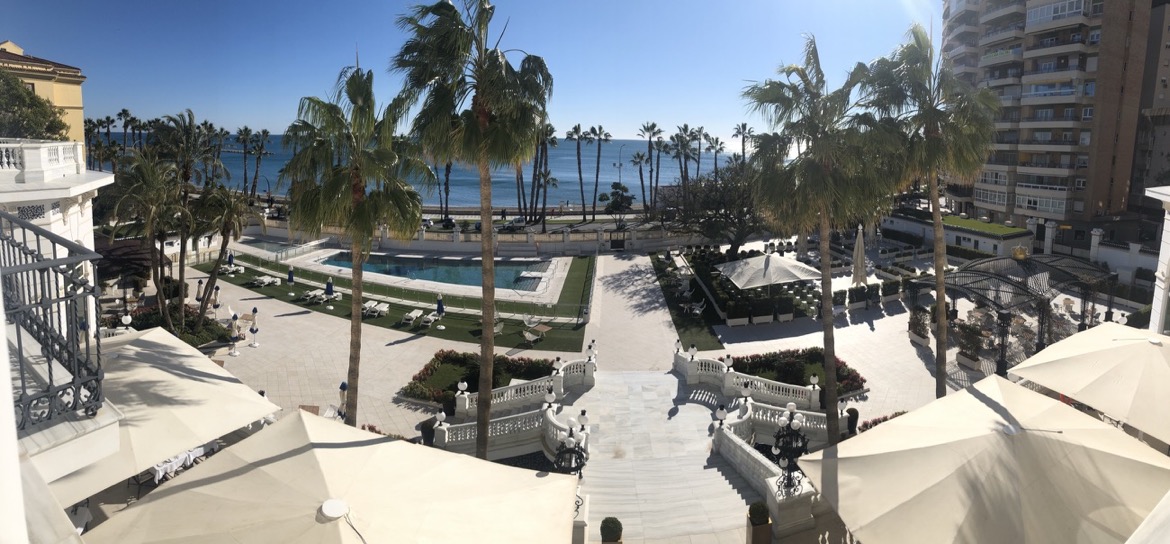

We can also stand on the promenade and view the grand façade of the hotel. Our hotel room was really very well placed. In the centre you can see four columns defining five arches, … that was the terrace to two hotel rooms, one of which was ours.

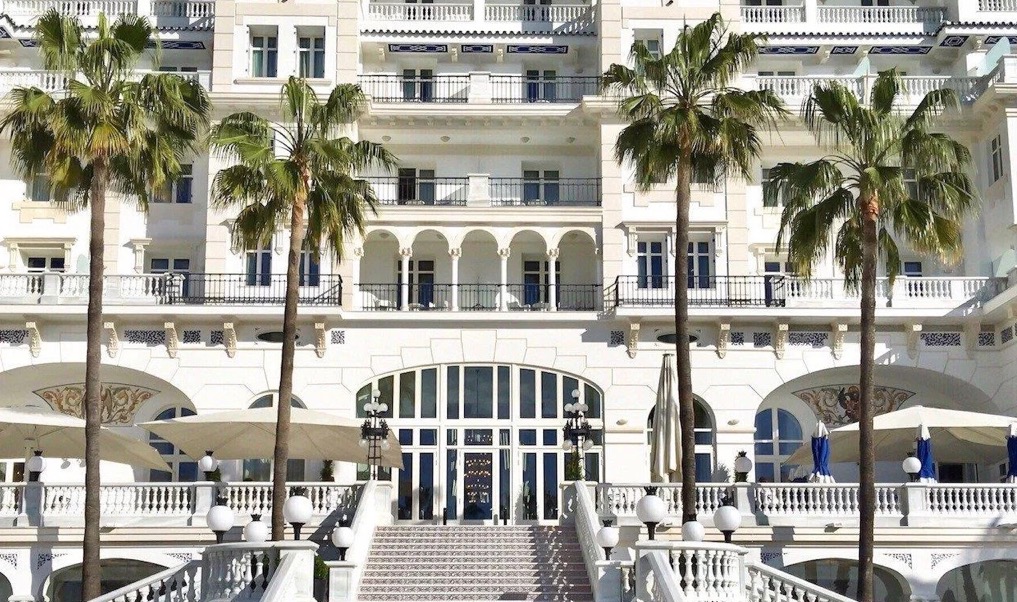
The façade facing the sea is quite impressive, both in its overall symmetry and sense of proportions.
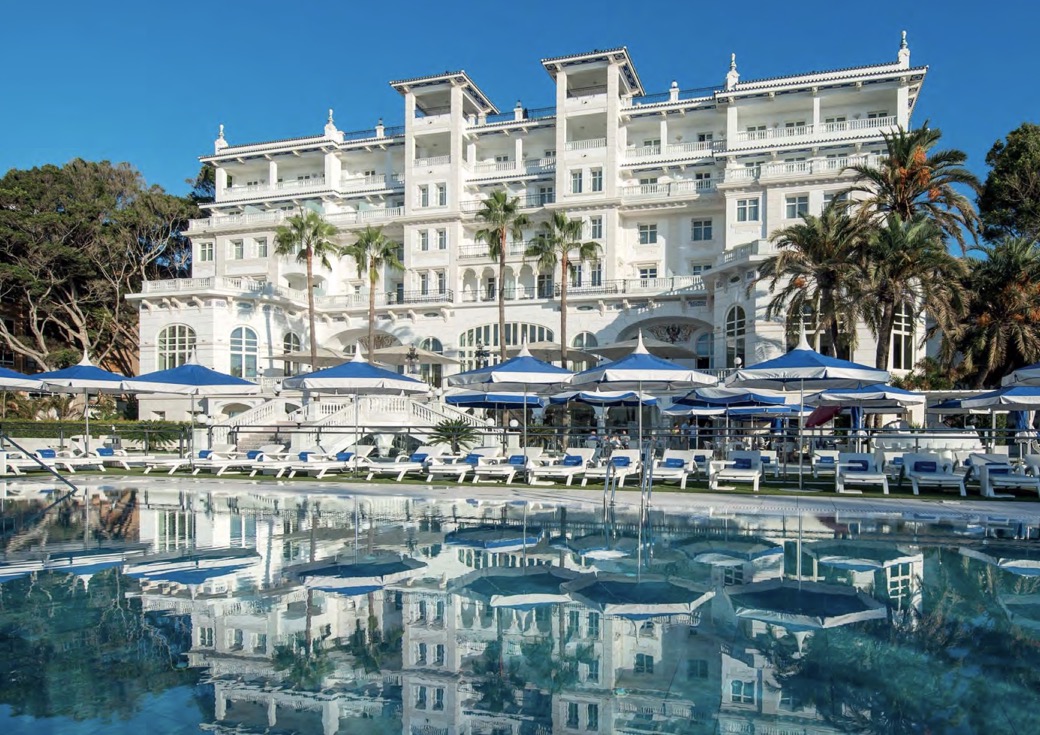
Above all I think I was most impressed with the architectural detail. The restoration was more than "just a restoration", the attention to detail and the investment was impressive.
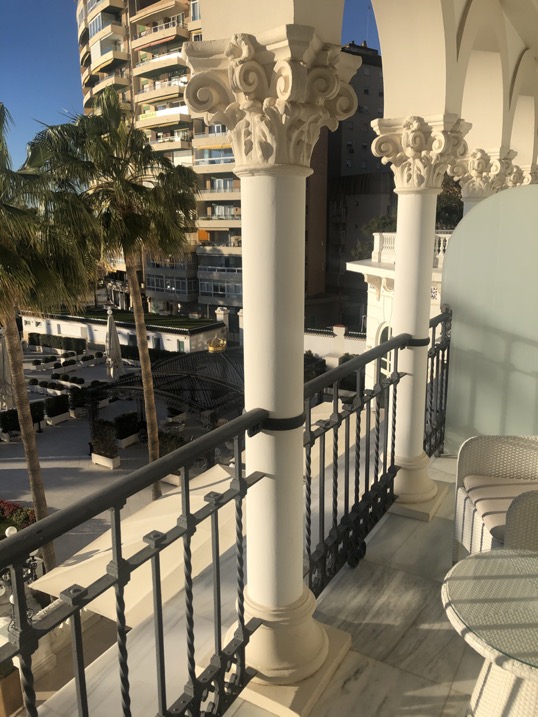

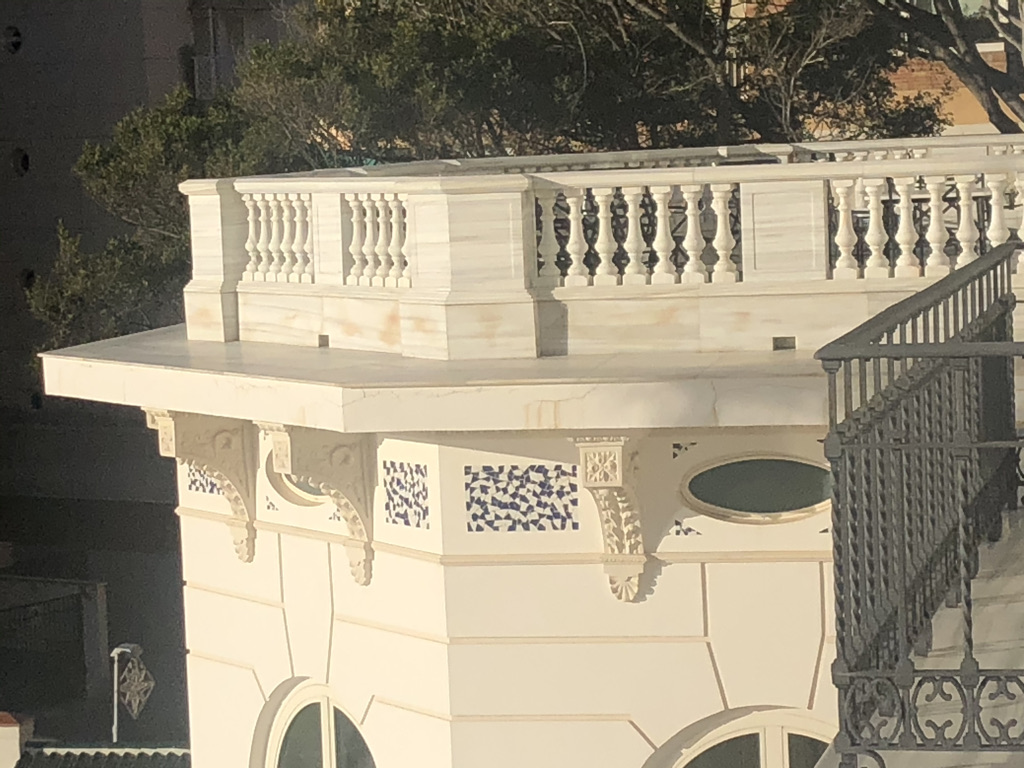
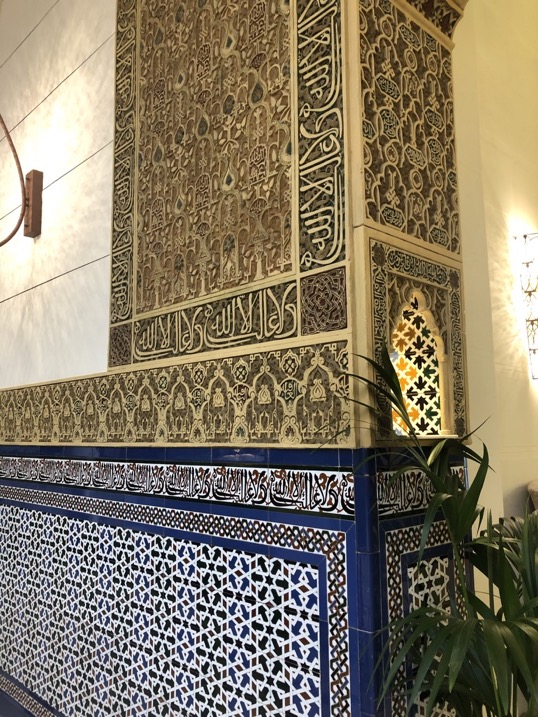
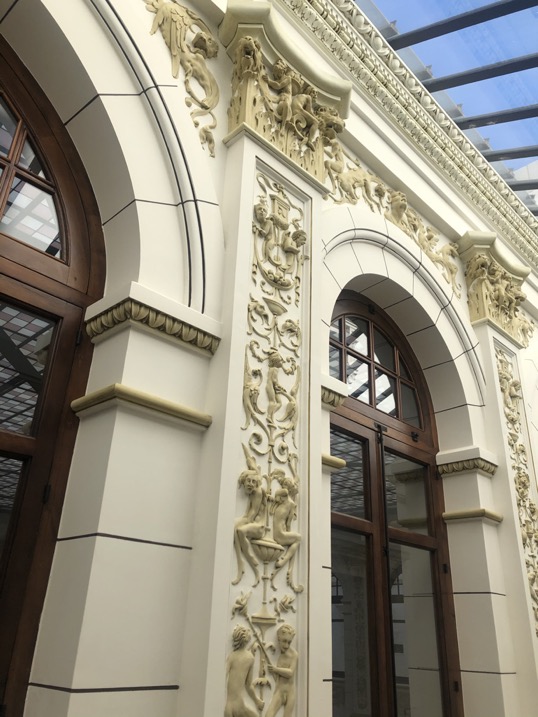

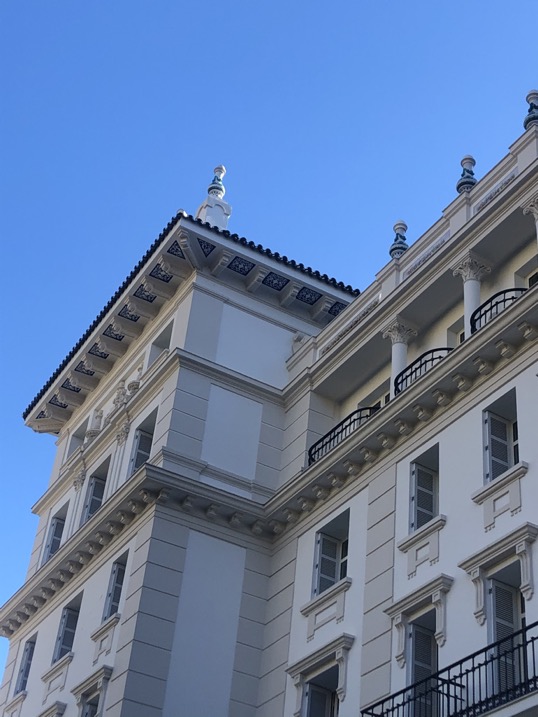
Our hotel room
The hotel, both on Booking and their own website, presents a variety of rooms, most decorated in a Moorish, Mudejar or Nasrid style, and the different descriptions and reviews mention white travertine marble, lacquered and stripped noble woods, golden bronze and silver light fittings, arabesque style lanterns, Miramar blues, gold tassels, braided cords, and even wrought iron.
The hotel website mentions seven room options, starting with the 30 square metre 'Premier' and ending with 80 square metre 'Royal Suite'. Booking mentions a larger variety of rooms, but the most important point to note is that only a small number of room have a sea view. As far as I could tell the majority of rooms face the front gardens or side roads. We picked a "Deluxe Room with Sea View" including breakfast, and completed the pre-paid booking on the hotel website.
On the hotel website we learnt that the room had 37 square metres, queen sized bed, a living area with sofa bed, en-suite bathroom with shower and separate bath, and all with an "alluring elegance and refinement". The list of features was quite complete, but our room did not have the sofa or a pillow menu. What was important for us was a separate walk-in shower, free wi-fi internet, wall safe, 24 hour room service, and secure parking.
We were particularly disappointed to find that room service was both poor and far from being 24-hour.
For the same room, Booking mentioned 37 square metres and a 'unique decor'. They mention air/con, flat-screen TV with satellite channels, Bluetooth sound system, USB and HDMI connections. The bathroom includes a bath, bidet, a mirror with temperature and clock, bathrobe and slippers, and high-end toiletries. In the 'private bathroom' there is a bath, toilet, shower, bidet, hairdryer, bathrobe, slippers, towels, free toiletries, and (even) toilet paper. And the room facilities are listed as - entire unit located on ground floor, entire unit wheelchair accessible, linen, alarm clock, wardrobe or closet, baby safety gates, minibar, air conditioning, safety deposit box, tile/marble floor, soundproofing, coffee machine, electric kettle, sofa, desk, seating area, telephone, satellite channels, radio, pay-per-view channels, flat-screen TV, iPod dock, cable channels, socket near the bed, and wake-up service.
Frankly, you have question the sanity of the people who wrote and published this information on the Booking website. Toilet paper? Linen? Soundproofing? And what is the alternative to "private bathroom"? Naturally I can confirm that all these 'features' were present in our room. However, our room was not on the ground floor, did not have wheelchair accessible, nor a baby safety gate, and there was no electric kettle and no sofa. In fact, as far as could see, you can't have a full sea view and a room on the ground floor, since the first two floors are reserved for restaurants, etc.
The really tricky issue was as follows. You will notice that for the Deluxe Room with Sea View there is no mention of a balcony or terrace (even if they appear is some of the photographs). In our booking we ask if it was possible to have a sea view room balcony or terrace. And in fact, that is what we received.
But did that imply that our room would not be identical to a Deluxe Room with Sea View? The reality was that it was smaller than that mentioned and shown on the websites. Below is what is presented on the web, and the suggestion is that the total space was 37 square metres and there was a sitting area with a sofa. We did not receive these facilities, we had a more limited sitting area with one single seat and a small round coffee-style table. My estimate was that instead of 37 square metres we received about 27 square metres, but we also had a terrace of about 6 square metres. This meant that whilst we retained the desk and desk seat, the TV was placed in front of the bed, rather than in the sitting area.
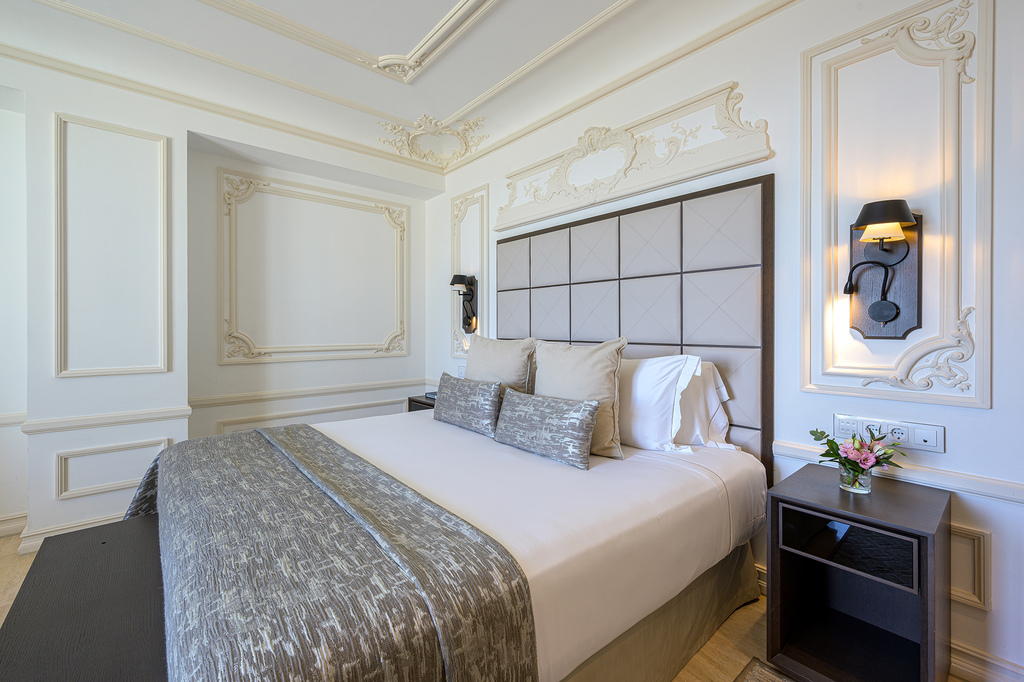
In f act our room's decoration was identical to what we see above. The decorative style and furnishing were identical, The bedhead, throw and decorative cushions were identical. The carpet and flowers had disappeared, COVID oblige. We even had the same odd looking bedside lighting features.
There was no information provided in the room confirmation, it just said 'sea view'.
Frankly, we were more than happy to exchange a sitting area for the outside terrace. However, the reduction is space could be felt in the more limited wardrobe space, and above all in the bathroom.
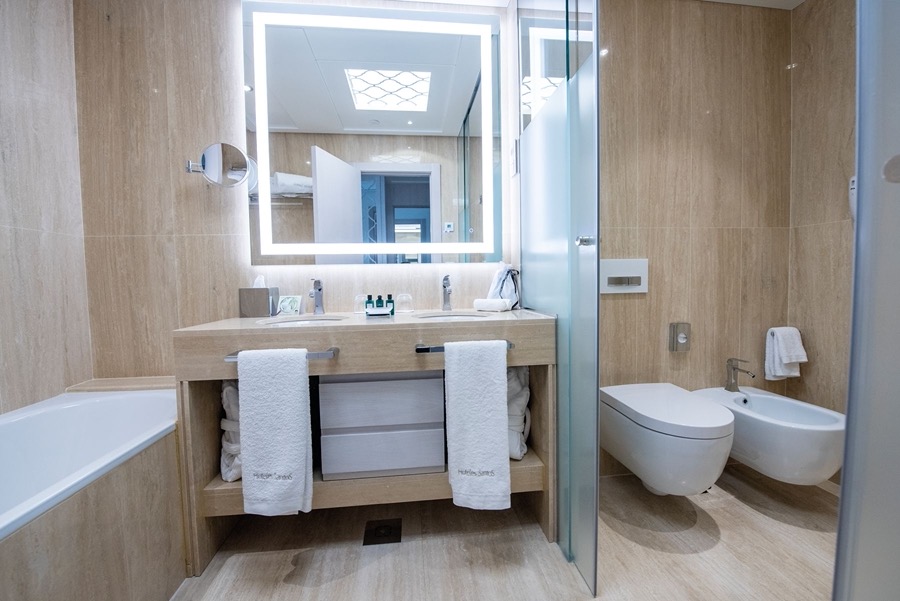
Above we have the bathroom as presented on the websites. It looks very acceptable, but the reality (at least in our room) was that in a space of 5-6 square metre they squeezed in a bath and two hand basins, plus a sliding separation and a shower, WC and bidet. Now matter how you arrange things, something has to give. And in this case it was the shower.

As we can see above the shower was just a little too tight for real 5-star GL comfort. In addition there was a major design fault. The retention bar along the foot of the door was not perfect, and above all there was a 0.5 centimetre gap between the shower doors. The result was that taking a decent shower mean partially flooding the bathroom floor.
Other issues worth noting. The left-hand glass sliding door stuck, and when pushed the handle had started to chip the fix glass wall on the left-side. Also the right-hand basin could not be closed to retain water. Otherwise, the bathroom did the job, even if it was a bit 'tight' (a bit like a 5-star caravan came to mind).
Summarising our opinion of the room.
Positives:-
Well decorated, and well appointed room.
We loved the terrace, and we spent at least a couple of hours per day sitting and just appreciating the sun and the views.
The heating air-con worked really well.
The TV with the film options was appreciated.
I was happy to see the different IT connections, etc. (plus plenty of power sockets).
Very comfortable bed, and I loved the ezi-maid lifting mechanism that certainly made things easier for housekeeping.
Negatives:-
Tight bathroom, with small, leaky shower.
Damage to wardrobe door indicates that the entrance is narrow, and it touches the room main door when opened.
Curtesy lights in wardrobes did not work.
Pillow choice was between very hard and very soft.
Food
The hotel website claims 3 restaurants and 2 bars, but only presents three options:-
The "Royal Lounge" set in the atrium/lobby.
Príncipe de Asturias Restaurant, with a sea view.
Mediterráneo Restaurant, for the breakfast buffet.
Let's start with the "Royal Lounge". After checking-in we thought to have "tea and cakes" in the central atrium. However we were told that the service was limited to tea but no cakes, etc. Fortunately the waiter suggested we try for tea and a dessert in the Príncipe de Asturias Restaurant. The nice thing about Spain is that you can expect restaurants to be serving even at 16:00 in the afternoon. We were served with an elegant tea, a very tasty dessert, and my wife had a very nice salad of fresh fruit.
Our intention was to focus on in-room dining, both for breakfast and evening room service. So we turned to the TV presentation of the 'food' options:-
Breakfast 08:00-10.30
Príncipe de Asturias 13:00-16:00 and 19:00-22:30
Snack & Room Service
The menu of the Príncipe de Asturias Restaurant looked interesting, and still reasonably prices for a 5-star GL hotel. However the menu was the same for lunch and dinner. In the lift an executive lunch menu was mentioned, but no information was available on the TV.
The real problem was with the Snack & Room Service. Firstly it was limited to 11:00-13:00 and 16:00-19:00, so not at all 24-hour. Secondly the room service menu consisted of a very limited number of options, namely, expensive Jamón ibérico, mediterranean salad, mixed sandwich, two pizza options, a fruit salad and a Brownie.
As a point of comparison, our 4-star Christmas stay-over hotel in Ronda offered their entire menu as room service until 23:00.
We knew the fresh fruit salad would be a success, but we also tried the mediterranean salad and the simple Margarita pizza option. The mediterranean salad consisted of a lot of salad ingredients dumped into a large bowl. There was no specific salad dressing, but there was some pre-packaged olive oil, mayonnaise and mustard so you could "do it yourself". The salad dressing ingredients were so limited, and the salad so big, that the dressing appeared to have no effect on the taste of the raw salad ingredients. The pizza came in a specially heated box fitted to the folding dining table. It looked perfect, but somehow disappointed. I'm not sure why, maybe the cheese used, but I think a spicy olive oil would certainly have helped. The pizza looked like a pre-prepared option. If it was hand-made in the hotel kitchens, then they did a really good job in creating a pizza that looked like a standard industry pre-packaged version.
So overall, a very disappointing room service, and not at all a 5-star GL experience.
Let's turn to breakfast. No matter how you look at it, breakfast in the room was a nice experience!
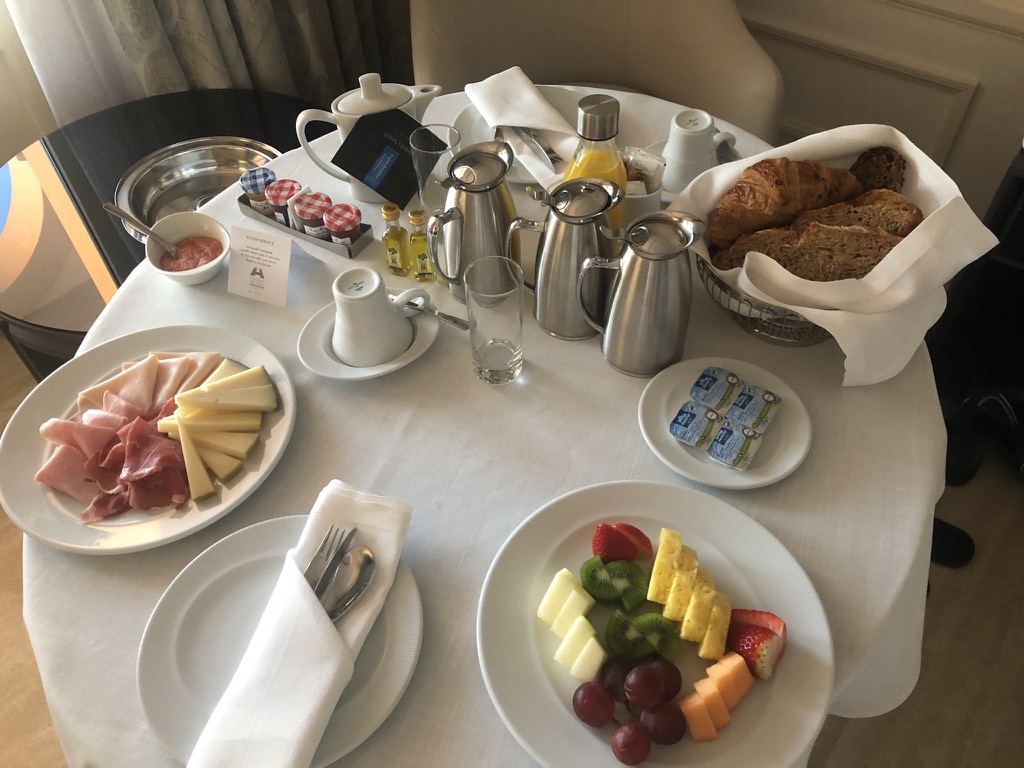
Fussy, don't call me fussy! But in a 5-star GL hotel everything depends on the detail. Day two breakfast came with less hot milk, but a few extra pastries, but less butter. Day three breakfast came with the cheese and meats on different plates, the juice already in the glasses, the fruit in six individual plastic containers, two yogurts, but no tea for my wife. And, the 'tortilla a la francesa' had become a fried egg. Day four was more or less like day one, but less hot milk and less butter.
Our last day, we decided to challenge them. We asked for two fried eggs and bacon, and no cold ham and cheese option. Our eggs and bacon were in the hot cabinet installed on the fold-out breakfast table. The fruit had reappeared in six individual plastic containers. Orange juice was already in the glasses. But this time there were no pastries and they had forgotten my wife's tea (again). This last time one of the coffee cups had a deep chipped rim.
Interestingly each day the table was set with a little collection of sugars, etc., except on the 4th day. The waiter informed us that he would put the items we wanted on the table, but he could not let the collection of sugars, etc. enter the room (COVID oblige).
Whatever arrived on the our little breakfast table, it was always a delight to sit and drink our coffee (or tea but not always) and watch the sun rise and day unfold over La Malagueta Beach.

The spa

I always try out the spa, and I enjoy as good sauna and hammam. As you can see it presents very well, even if it was actually somewhat smaller in reality. Access was limited, COVID oblige. As far I could see there were no changing rooms, so you had to come down in a bathrobe. etc. I tried the spa twice. The first time the sauna was at about 60° C and had heated up to about 75° C when I left, and the hammam was just about OK. On my second visit the hammam was cold but was heating up, and the sauna started out at about 70° C and got up to a decent 85° C. The standard 15-minute sand timer you find in every sauna was broken. The pool temperature was fine for me, but my wife would have found it a bit cold. Some of the jets, etc. did not work. The four titled seats you can see in the above photograph are often heated. I'm not sure if this is the case in this spa, but in any case they were cold.
There were no instructions about how to use a hammam, sauna, and wellness pool, and there were no alarm buttons anywhere.
Overall conclusion
Firstly, the team that restored the hotel to its present glory are to applauded, both for the quality of the work and for the major investment it entailed.
Our experience in the hotel was almost entirely determined by the fantastic weather we had and the terrance with the sea view.
Frankly, had we not had both the terrace and five sunny days, we could have easily left the hotel very disappointed.
There were problems with the cramped bathroom, the poor shower arrangements, and the lack of decent room service in the evenings. Maintenance could be improved, and the lack of consistency in the breakfast service is a bad sign.
In addition, despite spending the new year in the hotel, there was a total lack of atmosphere.
So would we return to this hotel. No, if we were to stay in Málaga again we would look to stay in the city centre. It is a shame, given the wonderfully detailed restoration, but this hotel both lacks character and does not deliver a 5-star GL service (both elements highly dependent upon the quality and commitment of the staff, or lack in this case). Despite the great terrace, I doubt that the sea view we had was worth the price.
Thinking back to our visit to the Hotel Balneario Las Arenas in Valencia. Both hotels are in the Hoteles Santos group, but we had the clear impression that Las Arenas tries to deliver, whereas Miramar is not even trying.